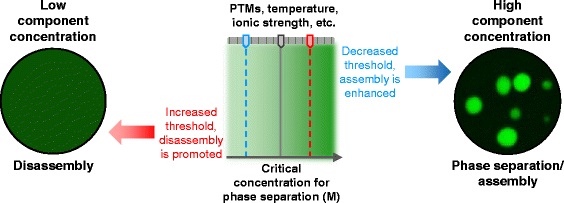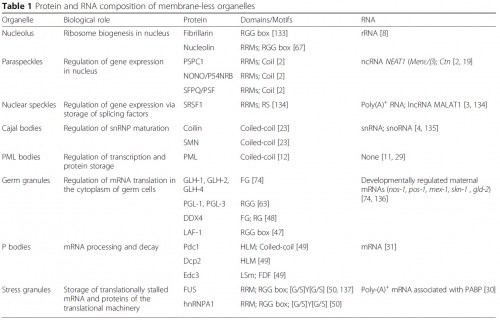
|
PIT00279 Биологическое разделение фаз При подготовке этого поста пришла мысль о возможности чтения и записи клеточной родословной путём биологического разделения фаз. Насколько это "наследуемо" в CellBook - вопрос открытый пока, но мы достаточно близки к его точной постановке, особенно, если включим в рассмотрение разрыв сплошности жидкой фазы твёрдой частицей (липидным рафтом = плотиком) или газовой прослойкой. От лирического начала биологического разделения фаз или P-гранул PIT00003 организация РНК в новом свете PIT00207 (добавил рисунок и дал ссылку открытого доступа) продолжает привлекать внимание. В перекрестии ссылок была найдена функциональная организация высшего порядка через разделение фаз в биологии, которая рассмотрена в статье Diana M. Mitrea, Richard W. Kriwacki. Phase separation in biology; functional organization of a higher order // Cell Communication and Signaling 14 (1), 1 (2016). DOI 10.1186/s12964-015-0125-7 (Прекрасный обзор в открытом доступе. Рекомендую прочесть!) Abstract. Inside eukaryotic cells, macromolecules are partitioned into membrane-bounded compartments and, within these, some are further organized into non-membrane-bounded structures termed membrane-less organelles. The latter structures are comprised of heterogeneous mixtures of proteins and nucleic acids and assemble through a phase separation phenomenon similar to polymer condensation. Membrane-less organelles are dynamic structures maintained through multivalent interactions that mediate diverse biological processes, many involved in RNA metabolism. They rapidly exchange components with the cellular milieu and their properties are readily altered in response to environmental cues, often implicating membrane-less organelles in responses to stress signaling. In this review, we discuss: (1) the functional roles of membrane-less organelles, (2) unifying structural and mechanistic principles that underlie their assembly and disassembly, and (3) established and emerging methods used in structural investigations of membrane-less organelles.  Рис. 1. Macromolecular condensation mediates the formation of membrane-less organelles. Membrane-less organelles are dynamic structures formed via a polymer-condensation-like, concentration-dependent phase separation mechanism. The critical concentration threshold (grey line) for phase separation can be tuned within a range of concentrations (shaded green box) through physico-chemical alterations to the system (i.e., posttranslational modifications to domains and/or motifs that alter the affinity of their interactions, changes in temperature, altered ionic strength, etc.). These changes can drive phase separation and assembly of membrane-less organelles, or their disassembly.  Рис. 2. Molecular basis for membrane-less organelles assembly. The proteins enriched within the matrices of membrane-less organelles commonly exhibit multiple modules that create multivalency, including folded binding domains (red) and low complexity regions (purple). Valency is often amplified by domains that enable homo-, or hetero-oligomerization (orange). Interactions between proteins containing different combinations of these interaction modules provide a framework for building a heterogeneous, infinitely expandable network within membrane-less organelles. Formation of this type of network drives phase separation when the critical concentration threshold is reached. For many of the examples discussed herein, active RNA transcription is needed for membrane-less organelle assembly. We hypothesize that expression of RNA in excess of a critical concentration threshold is needed to nucleate interactions with specific, multi-modular proteins, and for nucleating formation of membrane-less organelles. Stress signals can alter the multivalent interactions that drive phase separation and lead to partial or complete disassembly of the organelle. В этот обзоре есть достаточно полный список немембранных (membrane-less) органелл клетки, в который включены белки и РНК  Peter Belobrov 23 Feb 2016 13:12
© International Open Laboratory for Advanced Science and Technology — MOLPIT, 2009–2025
|